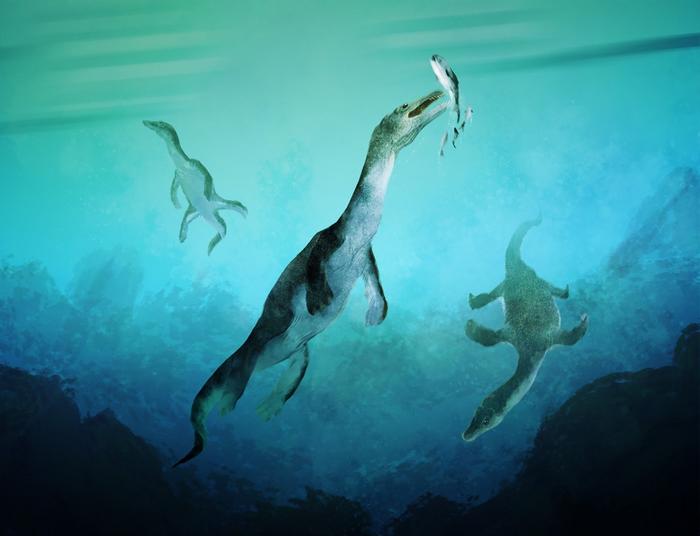A 240-Million-Year-Old Aquatic Reptile Fossil Challenges When Reptiles Ruled the Sea
Posted on Categories Discover Magazine

A new look at a nearly forgotten old bone could change the way we think about the reptiles that preceded the dinosaurs. And the revelation that the bone is the oldest fossil of an oceanic reptile from the Southern Hemisphere — reported in Current Biology — also serves as a legacy to the scientist who prompted its re-evaluation.
Dinosaurs and Ancient Reptiles
Reptiles ruled the seas for millions of years before dinosaurs dominated the land. Sauropterygians, were the most diverse and geologically longest surviving group of aquatic reptiles, with an evolutionary history spanning over 180 million years.
Marine reptile fossils linked to the beginning of the Age of Dinosaurs, have all been localized to an ancient low-to-mid-latitude belt spanning from what is today east Asia, the Middle East and Europe to northwestern North America.
“By contrast, the Southern Hemisphere has been a blank spot – until now,” says Benjamin Kear from the Museum of Evolution at Uppsala University. New Zealand was on the southern polar shore of a globe-spanning super-ocean called Panthalassa, “way off the beaten track of what we would expect for early marine reptiles,” says Kear.
Read More: 5 of the Most Interesting Prehistoric Marine Reptiles
Revisiting a Forgotten Fossil
In late 2018, Ewan Fordyce from Otago University in New Zealand rediscovered a marine reptile fossil from the South Island found by geologists in 1978 that had been largely forgotten. Fordyce alerted Kear and wanted him to take a look at the bone in the National Paleontological Collection at GNS Science New Zealand. COVID border closures delayed Kear’s visit.
“Sadly, Ewan passed away before I could visit him to see the specimen,” Kear says. But Kear obtained the fossil on loan from GNS science in New Zealand last year and engaged a team to analyze it.
When he and colleagues examined it, they realized it was a nothosaur, an aquatic reptile that lived about 240 million years ago and pre-dated the rise of the dinosaurs. Nothosaurs grew up to 22 feet long and paddled with four limbs. Their flattened skulls held slender conical teeth used to catch fish and squid.
Kear says the discovery is doubly significant — both for its age and location. In terms of age, the team determined it was 40 million years older than the previously known sauropterygian fossils from the Southern Hemisphere.
Read More: How the Age of Reptiles Began 250 Million Years Ago
Mapping Migration
The combination of the fossil’s time and place of origin — along with some sophisticated evolutionary modeling and mapping — shows that the nothosaurs originated near the equator and worked their way both north and south.
Their rise and migration likely started not long after a cataclysmic mass extinction 252 million years ago that marked the beginning of the Age of Dinosaurs.
“In a nutshell, this would then imply that ecological opportunism, adaptive evolution and globalization of the earliest land-to-sea backboned animal transition were interlinked and occurred simultaneously, or at least in very quick succession,” says Kear.
Read More: The 5 Mass Extinctions That Have Swept Our Planet
Discovering More Nothosaur Fossils
The exact route of the nothosaur migration remains unknown. Some theories suggest that they either traveled along northern polar coastlines, or swam through inland seaways, or used currents to cross the Panthalassa super-ocean.
But this new discovery will likely prompt more paleontologists to search farther and wider for more nothosaur fossils.
“As for where to find more, the possibility now is that we could find them almost anywhere that we have marine rocks of the right age and depositional setting,” says Kear. “To but it bluntly, the race is now on for the next discovery!”
The New Zealand nothosaur fossil is held in the National Palaeontological Collection at GNS Science in New Zealand. The authors dedicated the paper to Fordyce.
Read More: Why Were Prehistoric Marine Reptiles So Huge?
Article Sources
Our writers at Discovermagazine.com use peer-reviewed studies and high-quality sources for our articles, and our editors review for scientific accuracy and editorial standards. Review the sources used below for this article:
Before joining Discover Magazine, Paul Smaglik spent over 20 years as a science journalist, specializing in U.S. life science policy and global scientific career issues. He began his career in newspapers, but switched to scientific magazines. His work has appeared in publications including Science News, Science, Nature, and Scientific American.